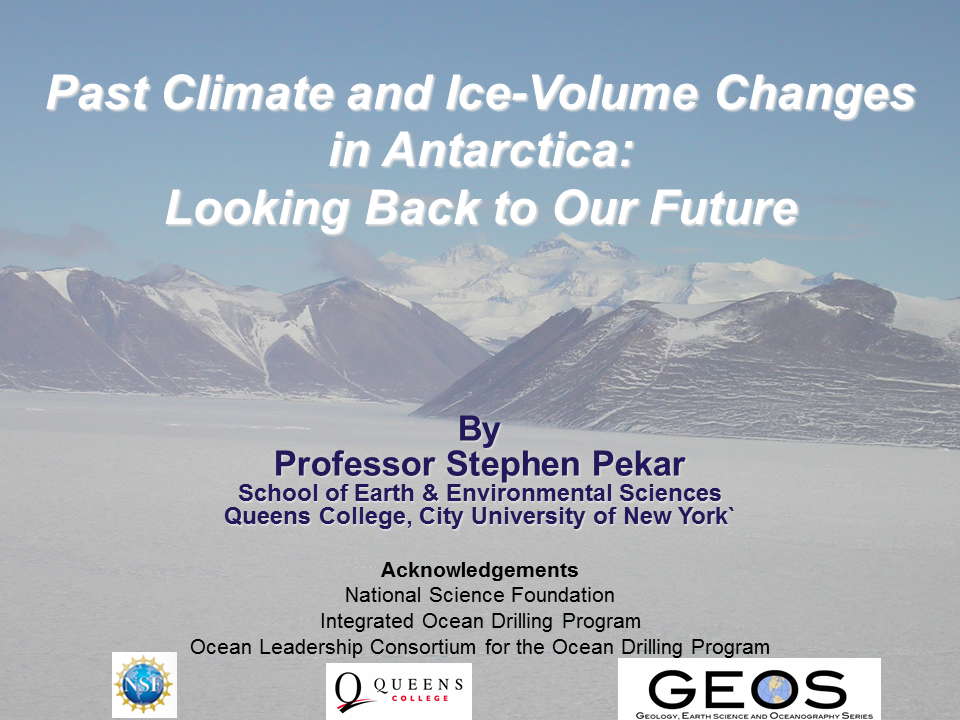Our Sept. 6th GEOS talk was from Dr. Stephen Pekar, he gave a brief overview of the history of the Ocean Drilliing program (from the time of the GLOMAR Challenger to today’s mega-research vessel, the Chikyu), followed by a wonderfully detailed discussion of changes in Antarctic Ice, with particular focus on how we know what we know about those ice changes.
 Opening Slide of Dr. Pekar’s presentation: Past Climate and Ice-Volume Changes in Antarctica: Looking back to our Future
Opening Slide of Dr. Pekar’s presentation: Past Climate and Ice-Volume Changes in Antarctica: Looking back to our Future
“The Ocean Drilling Program is the most successful international scientific program in the history of the world” and compares to NASA, which, Dr. Pekar noted, is a US-alone program.
To dispel any doubt that sedimentologists and stratigraphers deal with important and big issues in science, Dr. Pekar showed a whimsical but scientific reconstruction of Lady Liberty up to her neck in water in NY Harbor (with sea-level comparable to what is was before the formation of the Antarctic Ice Sheet). Reconstructions of Earth’s atmosphere in the past also showed that the last time we had atmospheric CO2 levels comparable to the IPCC estimates for 2100 AD was more then 25 million years ago, and that the atmosphere has changed faster in the past 100 years than it has in maybe the past 5 million, all of hominid history.
Diving into some of the nitty gritty of paleo-climate/paleo-oceanographic methods, Dr. Pekar talked about the critical role of the O-isotopic system in determining past ice volumes, the Mg/Ca temperature paleothermometer, and, an area he’s something of a pioneer on, the use of 3D backstripping in determining eustatic sea-level changes. He also discussed in some detail the “Late Oligocene Conundrum”, wherein it appeared that CO2 and Climate had decoupled for a period millions of years ago, and it’s ultimate resolution (there were issues of sample bias, with particular respect to the paleo-depth of the recovered proxies).
To wrap up this enlivening and scholarly discussion, Dr. Pekar also included photos from his latest field expedition, where he was one of the ship’s sedimentologists aboard the famed JOIDES Resolution, for the 2010 Wilkesland expedition. Most geology students are well aware of the exciting scientific voyages of the globetrotting JR, but work in the Antarctic added an extra element of “excitement”, evidenced in Dr. Pekar’s photos: 40 foot waves crashing over the ship’s bow. Despite working in inclement conditions, the crew of the JR was able to obtain some fascinating drill cores from the floor of the ocean, including a few sections that qualify as not just high resolution, but ultra-hi resolution, with thick zones filled with annual varve deposits of sediment, akin to obtaining a tree ring record, but from the bottom of the ocean, off of Antarctica, as one researcher noted.
This type of exciting work and command of the science involved is why Dr. Pekar, as he told me, currently has 9 students working on research projects in his lab at Queens College. Our group was excited to hear about his research, and this definitely set a standard for academic rigour in talks for the semester.
Comments by rschenck